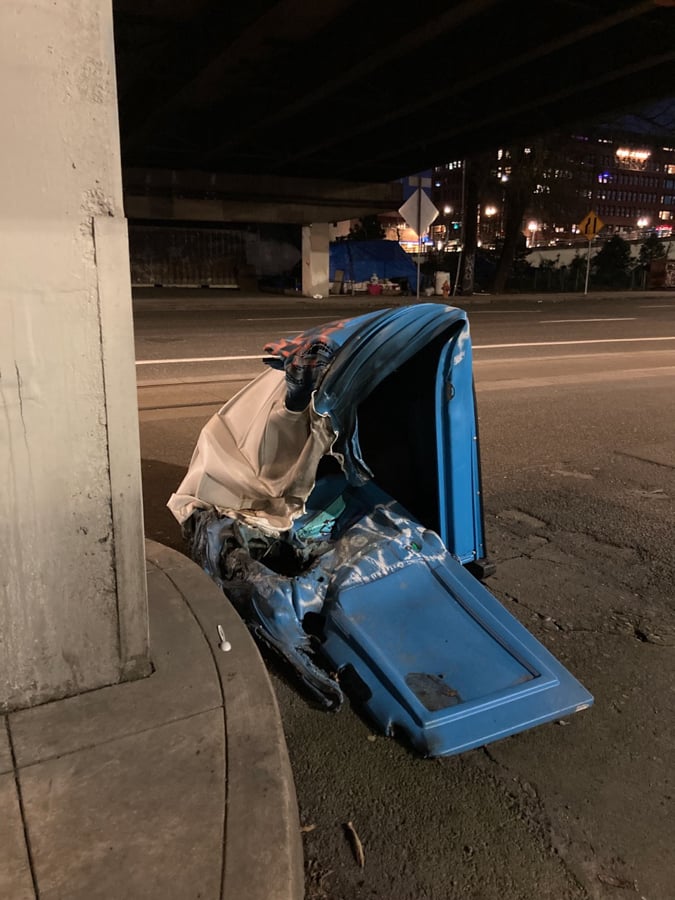Big Table #8 - It's a Beautiful Day in the Neighborhood
It’s Big Table n u m b e r eight, which rhymes with late. No further questions.
Welcome to the neighborhood! What happens in the neighborhood?
We have good clouds sometimes! You can get some artisinal salt or some fancy shoes. There's art everywhere. There are lots of important annoucements! You can watch Denis Villeneuve's critically acclaimed Dune movies. That's not even the only van around, either! Oh, don't forget the Street Potato!
And if you're looking at the street in Buckman, why, you just might spot a newly-described substance. Introducing:
[̲̅B][̲̅u][̲̅c][̲̅k][̲̅m][̲̅a][̲̅n][̲̅i][̲̅t][̲̅e]
Buckmanite, or Buckman Slate, is a metamorphic substance endemic to many urban environments, but first identified in the Buckman neighborhood of Portland, Oregon. It is a composite material formed when plastic municipal containers undergo rapid exothermic reactions, deforming to bond with the surrounding environment. These reactions are most often triggered by human intervention, both accidental and intentional, but theoretically could be triggered by natural phenomena such as lightning or incidental lensing of sunlight through nearby mirrors or windows during a heatwave.

Buckmanite usually ranges from dark to light blue in appearance, while green, brown, and even yellow varieties have been identified. When fully formed, Buckmanite is usually found in wide, pool-like deposits characterized by an irregular, layered surface, mechanically bonded to the ground substrate. Buckmanite is unusual in its ability to form novel cement-like structures and fuse with existing cement or composite materials.
Buckmanite as cement matrix
Many factors influence the composition of Buckmanite. The time of year, time of day, microclimate, and even the side of the street on which Buckmanite forms can dictate the internal structure of the material. Substances within and without the original form of the container will become suspended in the transformed material. These include leaves, inorganic refuse, and grains of sidewalk or asphalt up to 1cm across.

Buckmanite as cement ingredient
Significant deposits can be easily removed with common hand tools, but thinner layers may integrate so fully into their environment as to become a permanent feature. Pre-transformation, the polymer components of Buckmanite are fully mobile in relation to the cement surfaces of its typical environment. The energetic process of its formation bonds the material to its hyperlocal environment. In this way the material represents a transition from container to surface.
Even partial formation of Buckmanite is enough to cause an ontological metamorphosis of its source materials. Here, a container has lost its internality and has become refuse in need of containing.

Exotic components
Buckmanite is defined by a process and location as much as it is by pure material composition. Many different possible structures and appearances of Buckmanite have been theorized. Pictured here is a dramatic example of the incomplete formation of Buckmanite from an atypical source. Note that the original structure was not able to sustain an exothermic reaction long enough to fully transform.
Environmental Indicator
While the physical components of Buckmanite are common, its formation most typically occurs within specific sociological conditions. These conditions can be grouped as Ignition Conditions and Formation Conditions.

Ignition conditions
A primary condition seems to be the intersection of consistent on-street activity within residential or mixed-use neighborhoods. The housed population and local businesses are responsible for the continued presence of refuse containers, and enough range of on-street activity will provide an ongoing presence of unsanctioned interactions (ie any interaction not within the use permitted by the city or private owners of the containers). The combination, will, in select circumstances, provide the conditions required to ignite the material.
Folk theories tend to assign responsibility to unhoused or otherwise indigent actors, but ample field observations contradict this theory. The crucial criteria here is activity on the street. Whether that activity comes from a housed or unhoused population is not relevant. Whether or not formation conditions exist, ignition conditions are frequently met by affluent residents of or visitors to neighborhood with a high density of alcohol-serving establishments or proximity to major sporting arenas. The common misconception that ignition conditions are necessarily intentional has been repeatedly disproven. In fact, accidental ignition is perhaps even more common than intentional.
Formation conditions
Perhaps as part of some form of ecological homeostasis, the conditions required for Buckmanite formation only exist in regions with inorganic substrates and little vegetation. Were refuse containers to be commonly found in rural or forested areas, ignition would likely cause a wildfire. Buckmanite exists in a space between controlled and wild environments. A refuse container completely destroyed by a wildfire is not recognizable as Buckmanite, just as a simple garbage fire that fails to bond with its neighborhood also fails to qualify as this unique substance.
Conclusions
Much like other modern minerals such as Fordite, Buckmanite is a material formed a specific time and place, reflecting the cultural conditions of its site.
Gallery
Please enjoy this gallery of Buckmanite Samples
Add a comment: